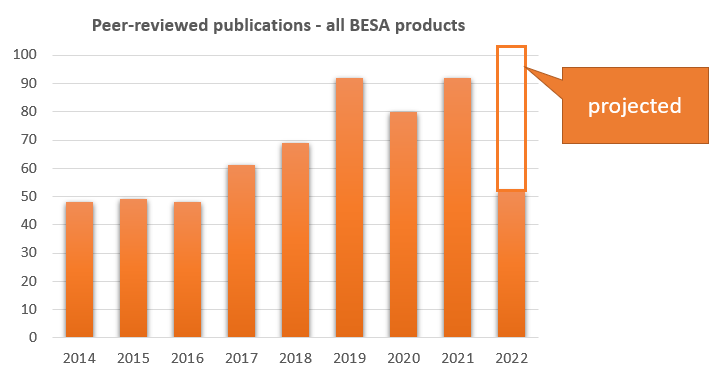We took a look at the number of publications created using BESA software. And we need to conclude: the trend is positive! Each year, more publications get generated where BESA software is used.

In particular, over the last couple of years BESA Statistics and BESA Connectivity featured much more frequently than before, reflecting the trend to analyze brain connectivity, and to present statistically sound results using proven statistical methods.
Some highlights from recent publications (please note that there are many more exciting publications, however unfortunately we can only pick a few here) include:
Connectivity and neural oscillations
Plaska, Ng, and Ellmore investigated the effects of rehearsal on working memory task performance. In their study design (a modified Sternberg task), the participants were presented with meaningful images or images that had been scrambled. They were asked to create labels for them in one (rehearsal) condition, or to not create labels in another (suppression). Performance increased with rehearsal only for the scrambled images, which correlated with increased alpha and theta activity in the left anterior temporal region. The authors concluded that “rehearsal only benefits memory for visual stimuli that lack semantic information, and that this is correlated with changes in alpha and theta rhythms”. (Neuropsychologia 155, 107825)
Alain et al. looked into the causality behind age-related decline in vision, hearing, and touch. In their experiment where visual, auditory, and somatosensory areas were stimulated, older adults showed higher amplitudes of associated primary cortical areas compared to younger adults. Functional connectivity analysis revealed that “older adults also showed stronger neural synchrony than young adults between superior pre-frontal and sensory cortices”. The authors found that for all these modalities, a common cause for the decline can be hypothesized, and that their findings “highlight the role of prefrontal regions in exerting top-down control over sensory cortices”. (J Neuroscience 42:264–27, 2022)
Epilepsy analysis
Hashimoto et al. investigated the coupling between low- frequency and high-frequency activities (HFA) during tonic-clonic seizures in a retrospective study. The authors found that the main low-frequency band modulating the HFA shifted from the θ band in the tonic phase to the δ band in the clonic phase. (Clin Neurophysiol 137: 122-131, 2022)
Source analysis and statistics
Christiner et al. looked into the auditory processing of adolescents and young adults with dyslexia, correlating the auditory evoked P1-N1-P2 responses measured with magnetoencephalography with their ability in Mandarin syllable tone recognition, singing, and musical aptitude. Individuals with dyslexia showed prolonged latencies in P1, N1, and P2 responses compared to controls. From their cross-correlation analysis results, the authors conclude that their “study provides additional evidence that dyslexia can be understood as an auditory and sensory processing deficit”. (Brain Sciences 12:744, 2022)
Connectivity and statistics
Chow et al. studied resting-state brain connectivity in older vs younger adults using the default mode network (DMN). Using source-level phase locking value (PLV) analysis and statistics, they could show that for some frequencies (alpha2 range), connectivity between mPFC and other DMN regions was decreased, whereas for other frequencies (theta and beta bands), PLV between the mPFC and posterior cingulate regions increased. The authors conclude that “these results suggest age-related changes in DMN functional connectivity are non-uniform and frequency-dependent, and may reflect poorer performance in cognitive domains thought to decline with aging.” (Neuroscience 485: 116-128, 2022)

Comments are closed.